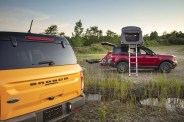The Wrangler has long been the iconic Jeep. Its progenitors helped the Allies win the war and established the brand’s off-road credibility. The Wrangler is the reason Jeep even exists today.
But the Wrangler is not Jeep’s most influential vehicle. That honor goes to the more humble, XJ-generation Cherokee, which Jeep built from 1984 to 2001.

How awesome was the XJ Cherokee formula? When Chrysler bought Jeep in 1987, they inherited the XJ Cherokee … and kept it in the lineup for another 14 years. This is why.
1. The XJ Cherokee was everywhere
Jeep sold nearly three million XJ Cherokees. If you grew up outside wintry Detroit like I did, the XJ was ubiquitous.
My parents had a Wagoneer model; my younger brother drove a Cherokee Sport; too many of my high school friends had them to bother enumerating.
Jeep sold nearly three million XJ Cherokees. It was ubiquitous.
The XJ Cherokee was everywhere — even in Father of the Bride, as the practical companion to Steve Martin’s pristine Austin-Healey 3000.
2. The XJ Cherokee ushered in an era of compact SUVs
One reason the XJ Cherokee become so popular was that it was ahead of its time. It was one of the first modern, compact sport utility vehicles that fused all-terrain capability, practicality and less-than-ogreish on-road manners.

Thanks to successors like the Honda CR-V, Toyota RAV4 and Nissan Rogue, that template would become America’s default car.
Upset that wagons have all but died in the American market? Blame the XJ Cherokee. After all, it was initially marketed as the “sportwagon.“
3. The proportions were close to perfect
The best way to understand the revolution the XJ Cherokee wrought is to look at the vehicle it replaced: the SJ Cherokee.
That SUV may inspire nostalgia now from the Bring a Trailer crowd but the SJ Cherokee was a hulking, full-size, two-ton-plus, body-on-frame SUV. It featured enormous 5.9-liter and 6.6-liter V8s. The SJ looked cool, sort of like a smaller Grand Wagoneer — but it was the anthesis of the modern SUV.

The XJ, in contrast, was a revelation. It carried over the Cherokee name but shrunk from a full-size SUV to a compact. It used a lightweight unibody construction instead of the classic body-on-frame.
The XJ had Jeep’s trademark all-terrain capability but it was maneuverable on the pavement.
That meant the new Cherokee dropped about 1,000 pounds of curb weight versus the previous vehicle while keeping most of the same interior volume.
The XJ had Jeep’s trademark all-terrain capability but it was maneuverable on the pavement and accessible to a wide range of buyers.
4. The XJ Cherokee had a remarkable engine
AMC knew how to build an engine. In 1987, the XJ Cherokee received the 4.0-liter inline-six, which is one of the best they designed. Chrysler then added a fuel-injection system, and the result was legendary.
That 4.0-liter produced formidable power and torque for the time: 190 horsepower and 225 lb-ft. The XJ was not a speed demon, but with that torque, it was surprisingly quick off the line.










